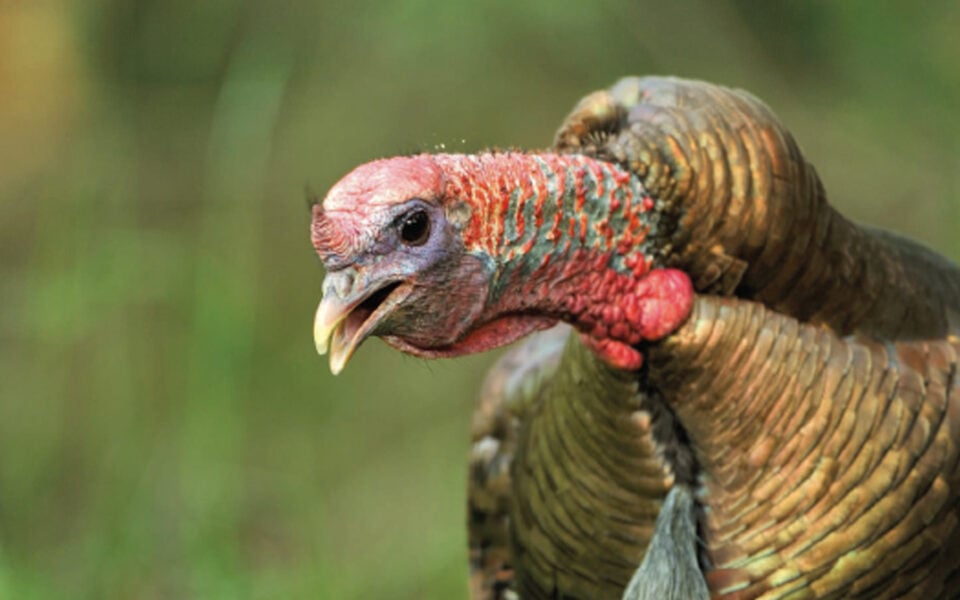Good communication skills are a big part of success in the human world, and likewise when turkey hunting. If there’s one facet of hunting the grand bird that thrills hunters most, it’s being able to “talk turkey” with wild turkeys. The term actually originated with wild turkeys. Historical accounts suggest the origin of “turkey talk” derives from colonial times when the first contacts between Native Americans and settlers often centered on the supply of wild turkeys and the day-to-day haggling over them, so much so that the Indians were said to have asked whenever they met a colonist, “You come to talk turkey?”
Today, the term “talk turkey” means to get down to business and speak directly. In the context of modern turkey hunting, to “talk turkey” means communicating directly with wild turkeys as if you’re a turkey. The message being conveyed with each turkey sound and when to use it is as important as mastering the call itself. Read on for tips on “talking turkey” so they’re convinced you’re one of them.
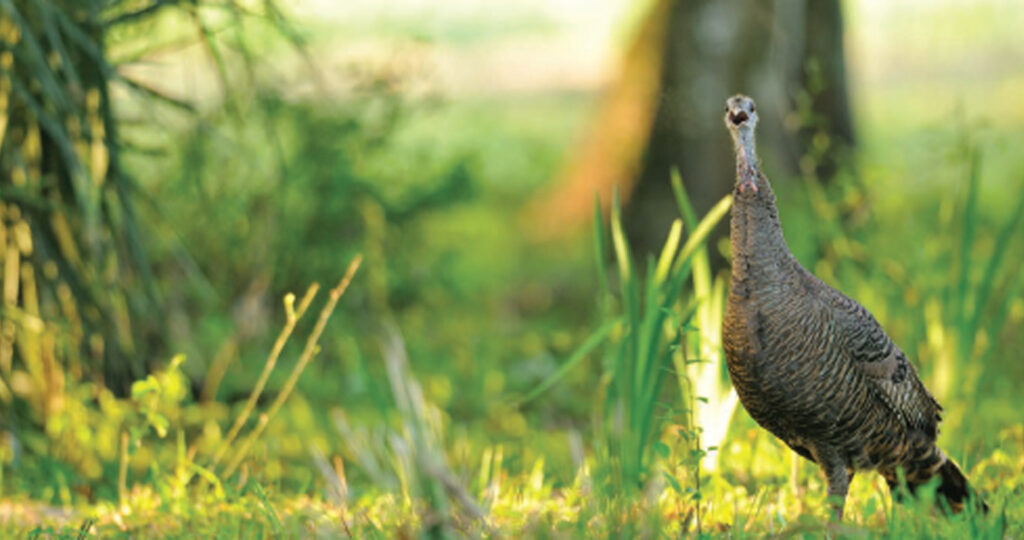
Tes Jolly – lost yelp
Plain Yelp
The yelp is a basic sound that turkeys use year round to communicate their location. The plain yelp of a hen is the most common turkey sound hunters hear. A series of 2 to 8 notes translates, ”I’m here, where are you?”. Volume, pitch and cadence may vary depending the bird’s attitude and age.
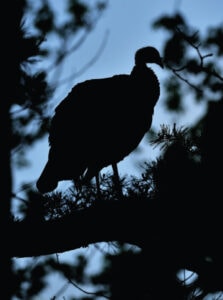
Tes Jolly
According to famed expert on wild turkey behavior and vocalizations, Lovett Williams, this call is often mistakenly referred to as the “lonesome hen yelp. The plain yelp, in fact, is made by both sexes. A gobbler yelp is a coarser “yawk” and some say sounds something like a dog bark. Jakes hanging with a strutter will often give a two to four note yelp in response to the gobbler’s spit and drum. This can reveal a non-gobbling turkey’s location to a hunter.
The plain hen yelp is a good call to begin a hunt for a gobbler. Start out soft with a short series. Turkey hunting veteran, Ron Jolly, has success in getting a gobble response by putting a bit more emphasis and volume to a single yelp midway through a 7 or 8 note series. Have a “meltdown” setup chosen before calling in case of a response nearby. In addition to a gobble, listen for a hen responding with yelps and/or clucks. Mimic her calls and you may fire her up enough to investigate. All the hen talk may get a gobble response too. Increase the volume and speed of the series, adding clucks then cutting as needed to match the turkey’s mood.
In sharp contrast to a thunderous gobble at daybreak that may carry a great distance, the soft tree yelp, or “tree call,” is a short-range sound. It consists of a series of soft, muffled yelps. These are made by roosted birds, just communicating with their flock members as they awaken. As fly-down approaches, the yelping gets louder and may be accompanied by soft clucks as the birds position to fly down for the day.
Use tree yelps sparingly when calling to a roosted bird, unless you’re in competition with other hens. Call softly and just enough to let him know you’re there. Too much calling and the bird may hang up on the roost, waiting for the hen to come into view, or he may fly down and go the other way.
Cackle
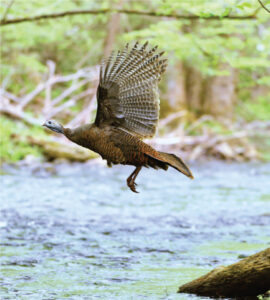
Tes Jolly
The cackle is used year round and generally associated with some type of sudden movement such as birds flying up to, or down from the roost, or when flying a creek, river, fence or from a ridge top. It’s a fast series of irregularly spaced cuts varying in number from a few to a dozen or more.
The fly down cackle combined with simulated wing flapping is a good strategy when you know the gobbler is on the ground. Typically, turkeys begin with a tree call indicating their location, then cackle as they leave the roost. It begins as quick clucks and cuts, and as the bird lands the cadence slows and often ends with yelps.
Use the fly down cackle when you’ve heard a gobbler fly down, provided he’s not in sight. Simulate wing beats along with the call. It may be enough to convince the bird one of his hens has landed nearby and he’ll move toward your set up.
Lost Yelp
The lost yelp is given by both adult sexes year round when attempting to regather after being scattered. The extended series of notes increase in urgency and rise in pitch. When hunting spring turkeys and a flock scattering is observed, set up at that location, wait fifteen to thirty minutes and start making long series’ of lost yelps. Birds wanting to regroup may respond. Be ready. They may come from different directions, quietly sneaking in or trotting hastily back to rejoin their flock mates. When other calls fail to elicit a response, try lost yelps whether you’re set up blind calling or covering ground to locate birds.
Assembly Yelp
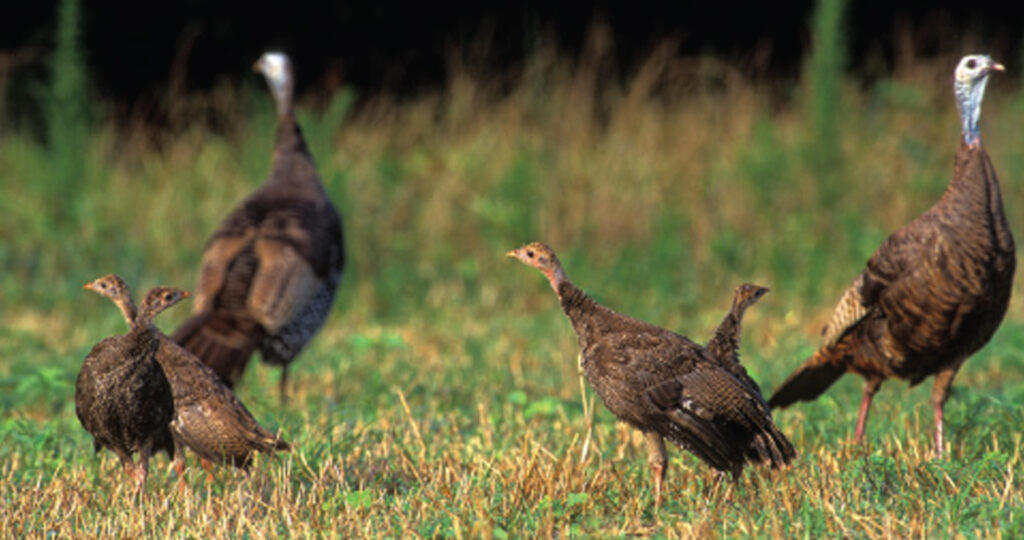
Tes Jolly – assembly yelp
The assembly yelp is used year round but more so in late spring, summer and fall seasons. Poults become familiar with the raspy adult hen assembly call within the first two days after hatching. The hen gives a very long series of yelps, a dozen or more, to regather her poults, or her flock. Young birds will also give this yelp along with a “kee-kee run” in the fall when they’re separated from the flock. Scattering birds is a common fall hunting tactic, and especially effective where both hens and gobblers are legal game. Set up at the scatter location once the flock has been broken up. Wait about fifteen to thirty minutes and begin making assembly calls.
Kee-Kee
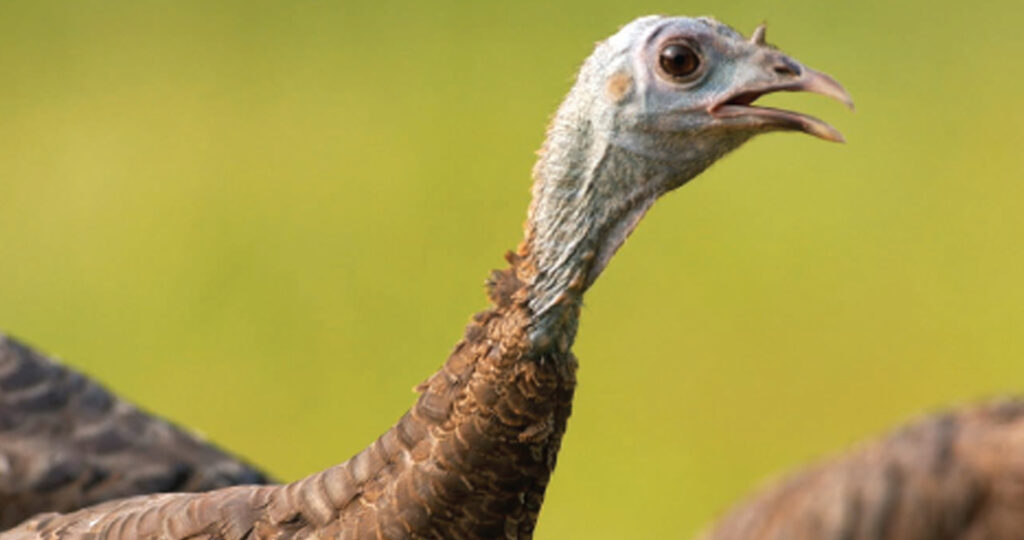
Tes Jolly
The kee-kee’s high pitched whistling notes are made primarily by young turkeys, especially during the fall. The pleading, “kee, kee, kee” sound is made when lost or scattered young turkeys are seeking to regroup with their mother or other birds in the flock. The “kee-kee run” is simply the kee-kee with a few yelps before or after. Adults make a variation of the call as well. The “kee-kee” and “kee-kee run” sounds are generally associated with fall hunting and used to call back birds after scattering the flock, but can also be used successfully during spring.
Purr
The purr is a close range contact call that communicates “all is well”. The soft, trilling or rolling sound is made by all turkeys year round and conveys “contentment.” Birds make this sound when relaxed, while feeding and to maintain contact when the flock is traveling. The purr is a great calming call when working a gobbler that’s close, but blocked by cover, hung up or needs to take a few more steps into shooting range. To avoid movement and spooking the bird, use a mouth diaphragm, gun mounted call or simply purr with your voice. Here’s a fun way to increase your turkey vocabulary. Turkeys make other barely audible sounds of contentment including pops, pips and whines. When opportunities occur (preseason scouting for instance), observe turkeys feeding or loafing and preening at very close range, listen closely for soft pops, whines and pips. Under good conditions, cell phone recorders can pick up these sounds. Compact video cameras do a better job. You can always go to YouTube for turkey videos with audio to learn turkey sounds, but who wouldn’t rather spend time in the woods with live turkeys as instructors? You’ll also be perfecting patience and the art of staying still. Make the calming calls with your voice or a mouth diaphragm.
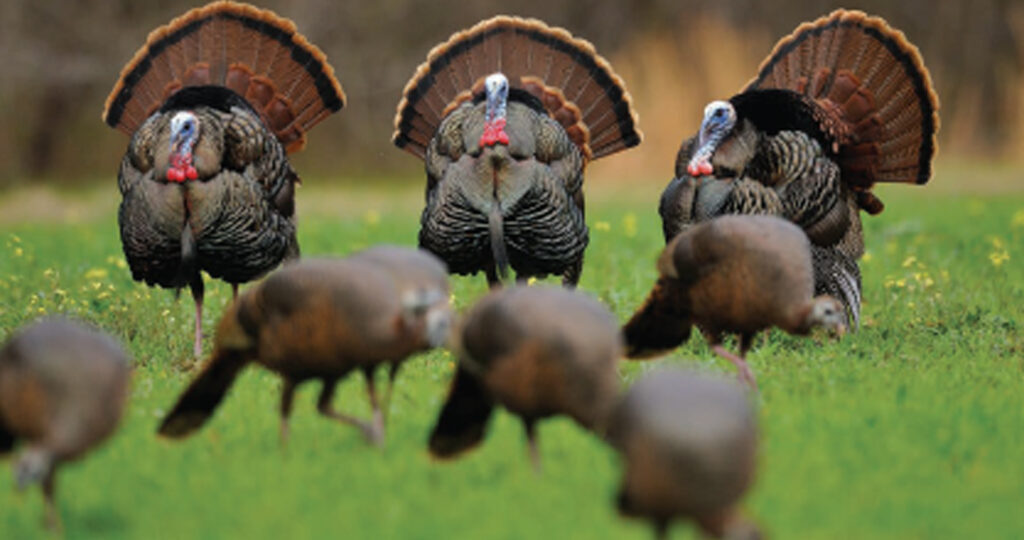
Tes Jolly
Loud and rapid purring signals aggression as turkeys of both sexes battle for dominance when winter flocks converge in early spring. Fights within a flock for gobbler breeding rights or boss hen status are noisy, feather-flying affairs with gobbles, clucks, cuts, yelps, purrs, wing flogging, spurring and beak stabbing. Later, gobbler territorial fights during breeding season can be violent with birds suffering substantial injuries mainly from spurring. Hen battles are less brutal, mostly chasing, pecking, foot jabs and wing flogging.
When imitating a fight, it’s easier if you have a buddy along. Make wing flapping noises and loud aggressive purrs with some cuts and a gobble or two (if conditions are safe) for half a minute or more, then be still, watch and listen. Fights can attract hens and gobblers of all age classes so listen for gobbles, yelps and clucks. A dominant gobbler, one ready to defend its territory, may approach to defend its breeding area. Let your patience level be your guide for how long to wait but remember, curious or subordinate birds may be wary and approach slowly and silently to investigate.
Plain Cluck
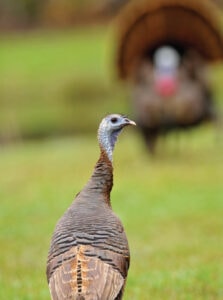
Tes Jolly
The plain cluck is a subtle, medium pitch call typically made singly or in a short series of two or three, staccato notes. It is used year round by both sexes when the bird is at ease and communicates “come here” or conveys location. There’s no set cadence and it may be broken by a yelp or two. Use the cluck as a contentment call. Make it to maintain a gobbler’s interest that’s moving toward you. If the bird is moving steadily, don’t call and risk it hanging up out of shooting range.
Modified Cluck
Excited hen cutting is a modified cluck, only the notes are louder, faster and more erratic. Cutting can be heard at long distances and is described as being questioning or seeking in nature. When hunting a henned-up silent gobbler, try cutting followed with a few loud yelps to get the boss hen fired up enough to respond. If she does, do your best to imitate her calls in pitch and cadence. This may provoke the hen to investigate the intruder, and hopefully with a gobbler in tow.
Excited hen cutting often motivates spring gobblers to sound off when other locator calls fail. It can be effective during the egg laying and incubation periods when gobblers spend long hours alone. Choose a setup before calling.
Cluck and Purr
Cluck and purr is related to flock talk. It’s used year round by all turkeys. A single cluck or two is followed by a soft purr and conveys contentment or a relaxed mood. This is a killer call when hunting and birds are nearby. Combine it with leaf scratching sounds to communicate a state of ease in feeding turkeys. The cluck and purr is effective in the same scenarios as noted with the purr. Keep it soft and don’t overdo.
Putt
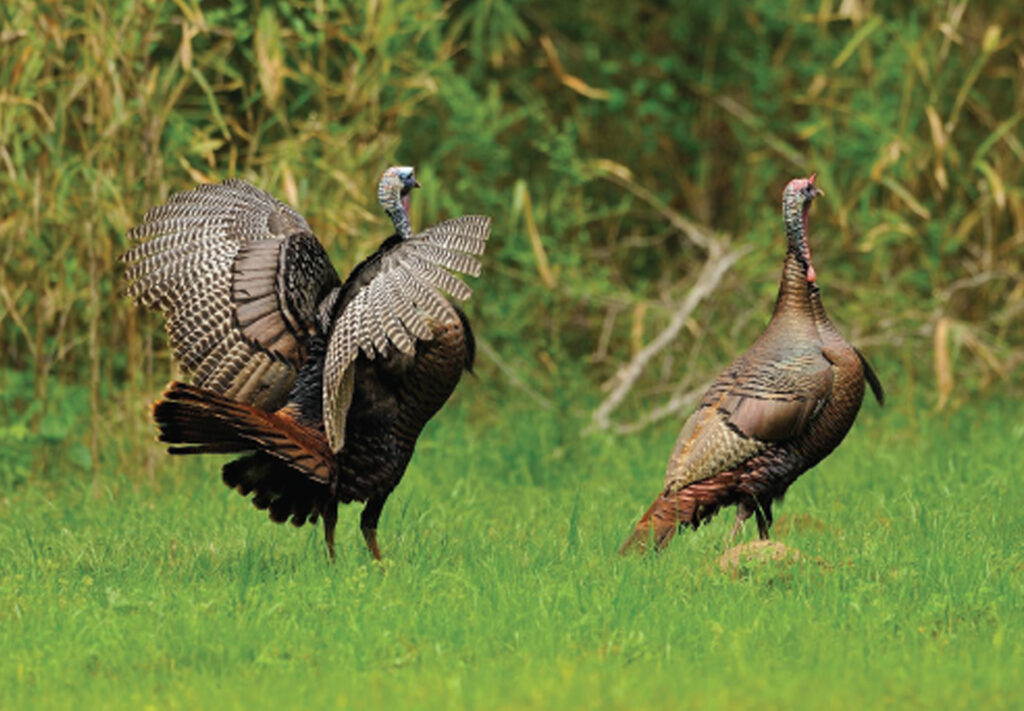
Tes Jolly
The dreaded “Putt!” is the call no hunter wants to hear. Veteran turkey hunter, Ron Jolly, tells novice hunters, “The difference between a putt and a cluck is whether the turkey is coming or going.” A slightly louder and more abrupt sound than a cluck, the putt broadcasts an alert to any turkey within hearing distance that something is suspicious, dangerous or just not quite right. It can be given in single putts or a rapid series. Sharp clucks followed by purrs are not as serious of a warning as are alarm putts followed by silence. Body language often distinguishes the difference between an alarm putt and an “at ease” cluck. A putting bird typically stands upright scanning the area. If it checks its wings, be ready, because an exit is imminent.
When hunting, don’t make the putt sound unless you want to clear the area of turkeys. It is useful when a gobbler is well within shooting range but fails to come out of strut. Give the alarm putt to make the bird raise its head to scan for danger, presenting a perfect shot. Warning: Be ready to shoot!
Gobble
The gobble is described as a thunderous, rolling, descending, throaty jumble of sound. It’s the most identifiable vocalization of the wild turkey and the trigger to an adrenaline rush in turkey hunters. The male gobbles primarily in the spring mating season to attract hens and to alert or ward off competing toms. Gobbling can occur anytime during the year. Hens are occasionally reported gobbling but the sound is more like a choppy, higher pitched jake gobble. However, some jakes mature into their gobbling greatness ahead of schedule, fooling the most seasoned turkey hunters.
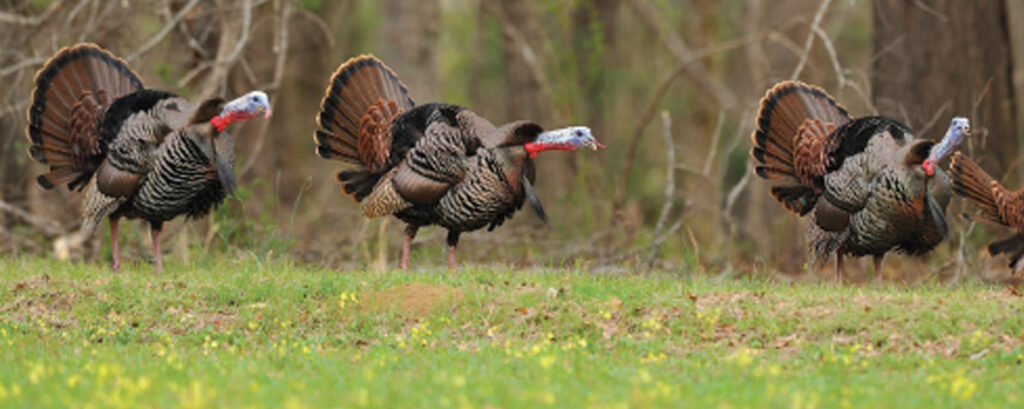
Tes Jolly – gobble
Start to finish, a gobble happens quickly, often lasting under a second. It’s nearly impossible to see all that happens in real time. Nearly twenty years of photographing wild turkey gobbling sequences has revealed several interesting details which occur with relative frequency during a gobble.
Thanks to luck and high speed digital image capture technology, an interesting pose appeared detailing how a tom tips it’s head down-ward, opens the beak wide, presumably to gulp air, before casting a gobble. It occurs in the blink of an eye and appears that it’s the fuel-ing charge for the gobble.
A behavior that regularly occurs during a gobble is the closing of the second, or inner eyelid. Often the lid will close just as the gobble starts and may do so again during the sound’s release. If the snood is elongated, it may be pinched in the beak during the gobble. Ouch!
It’s generally accepted that a hunter making gobbling calls may attract other hunters so use caution and avoid it on public land or when hunting unfamiliar areas. The gobble call can be effective in challenging another gobbler. It may cause the bird to approach the challenging gobble in a show of dominance to defend its breeding area.
Seasoned turkey hunters know that learning when to make the correct turkey sounds is as important as making them sound realistic. Good calling that’s overdone, too loud or made at the wrong time can spoil a hunt the same as poor calling and busting birds. The best way to learn the finer details of talking turkey is to dedicate time in the field observing and listening to turkeys going about their daily routine. Nothing beats hearing the sounds in a natural setting. To further sharpen your communication skills and be ready to “talk turkey”, visit Mossy Oak, NWTF and YouTube for audio and video clips of wild turkey sounds and calling techniques of the pros.

